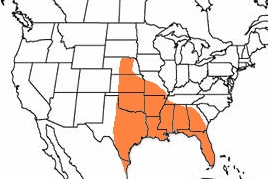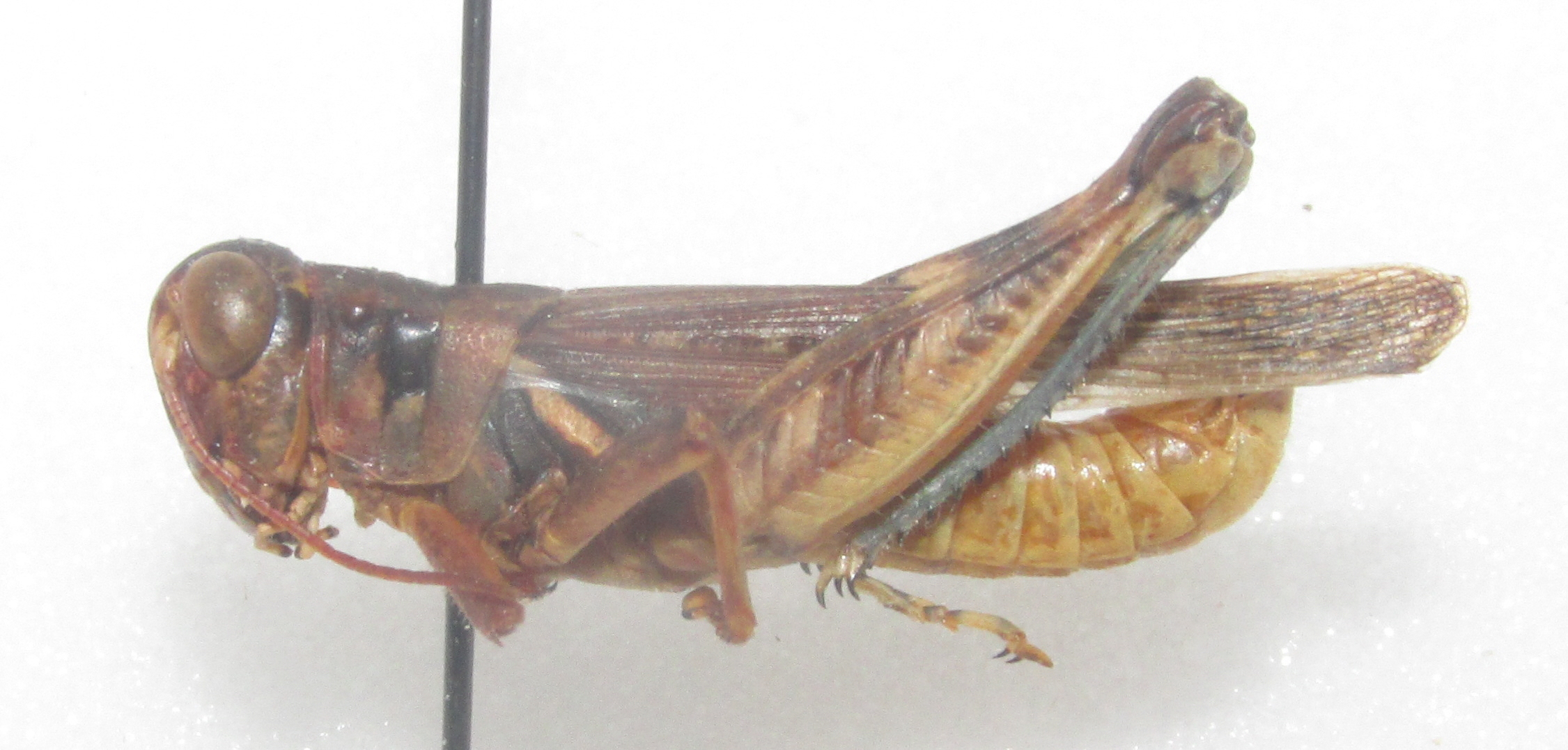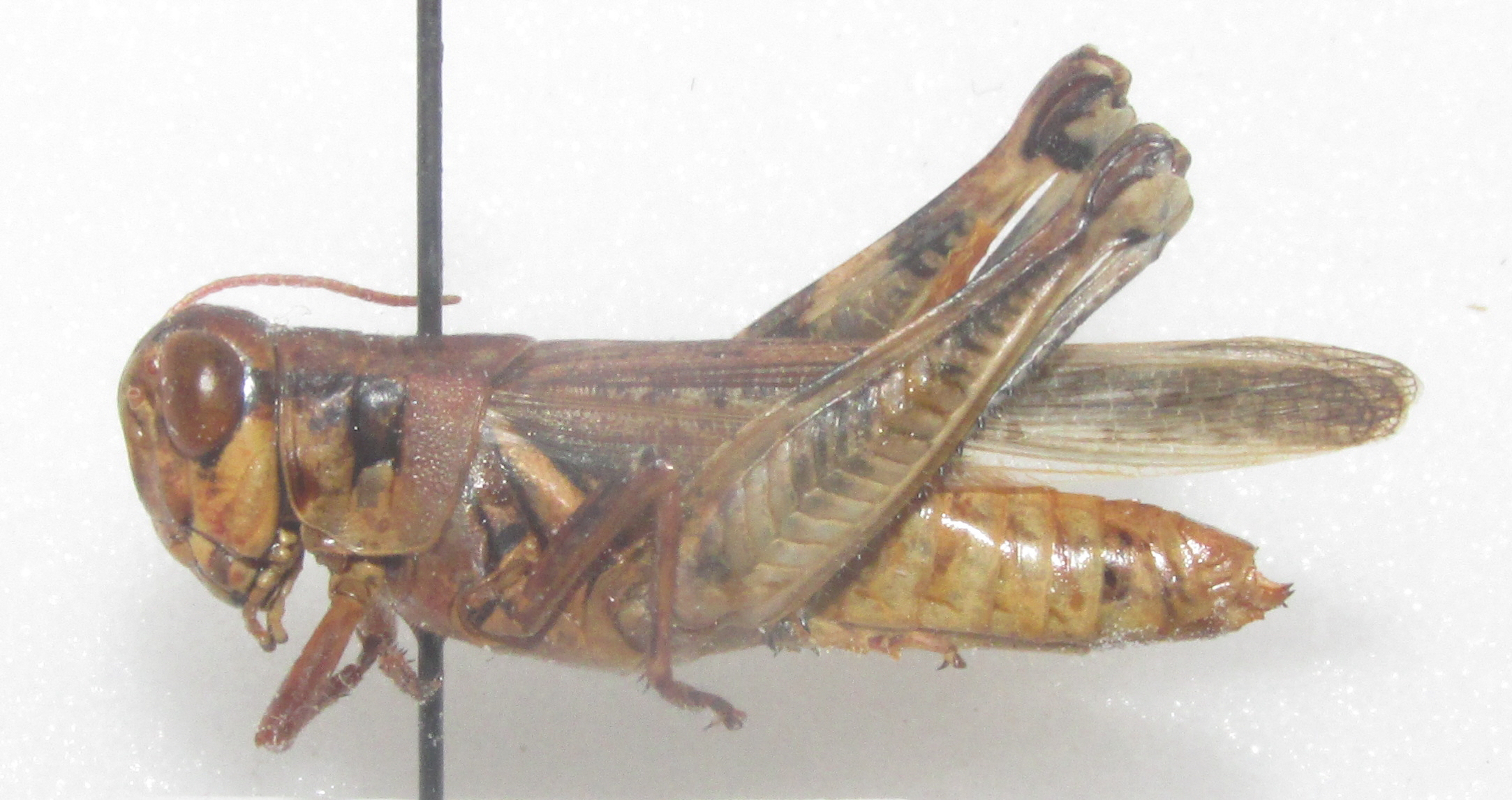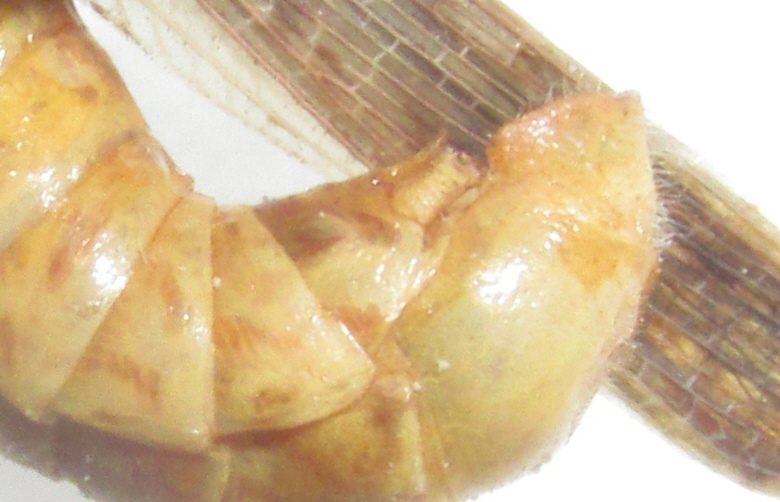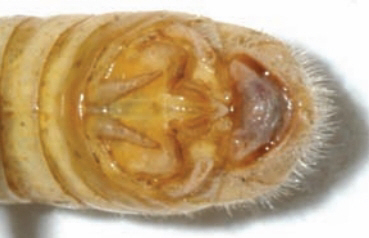Melanoplus bispinosus
|
Geographic range of Melanoplus bispinosus (Rehn) |
|
Fig. 1, Melanoplus bispinosus male |
|
Fig. 2, Melanplus bispinosus female |
|
Fig. 3, Melanoplus bispinosus hind leg, note the blue tibia |
|
Fig. 4, Melanoplus bispinosus male abdomen, note the small, spoon-shaped cerci |
|
Fig. 5, Melanoplus bispinosus male abdomen, note the bilobed supraanal plate |
Species
Two-spined spurthroated grasshopper
Melanoplus bispinosus Scudder
Subfamily Melanoplinae
Identification
A medium-sized Melanoplus distinguished from related species by its blue hind tibia (Fig. 3), its relatively small and spoon-shaped cerci (Fig. 4), and the bilobed supraanal plate (Fig 5). It is most similar to M. confusus, but with bolder markings on the outer hind femur and generally occurring later in the season.
Distribution and habitat
M. bispinosus is most widespread and abundant in the Great Plains, ranging from Texas north to North Dakota, with scattered records to the east in Alabama, Georgia, and Florida. This species is regularly overlooked, so it is likely more widespread than its current distribution indicates, particularly in the east. In the southern Great Plains it has been found in a variety of disturbed habitats, while elsewhere it seems to be closely associated with sandy environments, often along rivers. This species seems to be most abundant in Oklahoma, where it is noted as being recorded in almost every county in the state. In Oklahoma, it is reported to strongly favor overgrazed and eroded prairies over natural ones.
Economic importance
M. bispinosus is generally categorized as an innocuous species, but there is relatively little known about it. Its widespread presence throughout Oklahoma and its preference for pasture habitats in central Florida could allow this species to reach pest status during favorable conditions.
Food preferences
In choice tests performed using M. bispinosus from Florida, Richardia scabra L., Paspalum notatum Flüggé, Gnaphalium pensylvanicum (Willd.) Cabrera, Digitaria bicornis (Lam.) Roem. & Schult., and Brassica kaber (DC.) L.C.Wheeler were preferred host plants. They preferred a mixture of grasses and forbs, indicating a wide range of host species.
Dispersal and migration
Little is known about dispersal and migration in M. bispinosus. Both males and females are able to fly to escape enemies.
Hatching
Little is known about the hatching of M. bispinosus.
Nymphal development
Little is known about the development of M. bispinosus.
Adults and reproduction
Adults of M. bispinosus are typically found in late summer, July-September, throughout most of their range. In Nebraska, peak numbers occur in August and September. However, in Florida and Texas there are records for M. bispinosus nearly year-round, suggesting multiple, perhaps overlapping broods.
Population ecology
Little is known about the population ecology of M. bispinosus. It can be abundant where found, and in central Florida is considered the sixth most dominant species in pastures. However, it likely occurs in isolated populations throughout much of the eastern portion of its range, and it is considered very rare in both Alabama and Georgia.
Daily activity
Not known for M. bispinosus but likely similar to other diurnal Melanoplus.
Source and date
Oklahoma State University, July 2020 by Alexander Harman
Selected references
Brust, M.L., W.W. Hoback, and R.J. Wright. 2008. A synopsis of Nebraska grasshopper distributions. Journal of the Kansas Entomological Society. 81 (3): 208–255.
Capinera, J.L., R.D. Scott, and T.J. Walker. 2004. Field Guide to Grasshoppers, Katydids, and Crickets of the United States. Cornell University Press.
Coppock, S. Jr. 1962. The grasshoppers of Oklahoma. Ph.D. dissertation, Oklahoma State University, Stillwater.
Dysart, R.J. 1995. Relative importance of rangeland grasshoppers in western North America: a numerical ranking from the literature, pp. VI.6-1 to VI.6-20. In: Integrated Pest Management User Handbook. USDA APHIS Tech. Bull. Washington, D.C.
Hill, J. G. 2009. The grasshopper (Orthoptera: Acrididae) fauna of sand dunes along the Little Ohoopee River, Emanuel County, Georgia, USA. Journal of Orthoptera Research. 18 (1): 29–35.
Smith, C.C. 1940. The Effect of overgrazing and erosion upon the biota of the mixedgrass prairie of Oklahoma. Ecology. 21 (3): 381–397.
Smith, T.R. and J.L. Capinera. 2005. Host preferences and habitat associations of some Florida grasshoppers (Orthoptera: Acrididae). Environmental Entomology 34 (1): 210– 224.
Squitier, J.M., and J.L. Capinera. 2002. Habitat associations of Florida grasshoppers (Orthoptera: Acrididae). Florida Entomologist. 85 (1): 235–244

